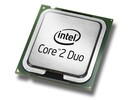Intel Core 2 Duo SP9600 vs Intel Core 2 Duo T9900
Intel Core 2 Duo SP9600
► remove from comparison
Der Intel Core 2 Duo SP9600 ist ein sparsamer High-End Dual Core Prozessor für flache Notebooks. Er basiert auf dem Core 2 Duo P9500, wird jedoch nur in BGA (Ball Grid Array) Ausführung angeboten zum direkten Auflöten auf das Mainboard. Dadurch ist die Package Größe des Prozessors auch deutlich geringer (22m2 versus 35mm2 beim P9500). Der SP9600 kann dadurch in sehr flachen aber trotzdem leistungsstarken Notebooks eingesetzt werden (z.B. Lenovo Thinkpad T400s). Der Stromverbrauch von max. 25 W TDP ist jedoch identisch
Die Performance des Core 2 Duo SP9600 ist vergleichbar mit dem ebenfalls mit 2.53 GHz getakteten Core 2 Duo T9400 und dadurch sollte sie für die meisten Spiele in 2009 ausreichen (nur GTA 4 profitiert deutlich von mehr Prozessorkernen oder höherem Takt). Der alte Core 2 Quad Q9000 wird auch bei den meisten Anwendungen geschlagen, da er mit nur 2.0 GHz getaktet wird.
Der Penryn (Montevina Update) Kern bietet 2 Integer Units, 1 Floating Point Unit, 1 Load Unit und 1 Store Unit in einer 14-stufigen Pipeline. Mit der Wide Dynamic Execution Technologie kann der Kern bis zu vier volle Instruktionen gleichzeitig ausführen.
Intel Core 2 Duo T9900
► remove from comparison
Die Intel Core 2 Duo T9900 Dual-Core CPU löst praktisch den Core 2 Extreme X9100 (ebenfalls 3.06 GHz und 6MB L2 Cache) ab und hat zusätzlich noch einen deutlich geringeren Stromverbrauch (35 versus 44 Watt TDP dank verbessertem Stepping und Enhanced Halt State (C1E)). Einzig der freie Multiplikator unterscheidet den X9100 noch vom T9900 und bietet einen Vorteil (die einfache Übertaktbarkeit per Erhöhung des Multiplikators). Die Architektur des Prozessors basiert auf den Penryn Kern und wird in 45nm gefertigt.
Dank der hohen Taktung von 3 GHz, ist die Performance für die alle Spiele in 2009 ausreichend (nur GTA 4 profitiert deutlich von mehr Prozessorkernen). Die alten Core 2 Quad Mobilprozessoren (Q9000, QX9300) werden dank der hohen Taktung bei den meisten Spielen deutlich geschlagen. Nur Anwendungen welche mehr als 2 parallele Threads effizient nutzen können (z.B. 3D Rendering) sind auf Quad-Core Prozessoren schneller. In der Einzelthreadperformance können erst die aktuellen Core i7 Modelle den T9900 deutlich abhängen.
Der Penryn (Montevina Update) Kern bietet 2 Integer Units, 1 Floating Point Unit, 1 Load Unit und 1 Store Unit in einer 14-stufigen Pipeline. Mit der Wide Dynamic Execution Technologie kann der Kern bis zu vier volle Instruktionen gleichzeitig ausführen.
Dank Dynamic Acceleration (später Turbo Modus genannt), kann sich ein Kern um eine Stufe übertakten, wenn der zweite im Idle Modus (Leerlauf) ist.
Das integrierte Enhanced Speedstep kann die Taktfrequenz des Prozessors dynamisch an die Leistungsanforderungen anpassen. Dadurch läuft die CPU ohne Last nur mit 800 MHz.
Der Core 2 Duo T9900 passt in den Socket P (mit 479 Pins):
Socket P / Micro Flip-Chip Pin Grid Array (Micro-FCPGA) requires 479-pin surface mount Zero Insertion Force (ZIF) socket (mPGA479M socket) or Micro Flip-Chip Ball Grid Array (Micro-FCBGA) for surface mount (479-ball)
| Model | Intel Core 2 Duo SP9600 | Intel Core 2 Duo T9900 |
| Codename | Penryn | Penryn |
| Series | Intel Core 2 Duo | Intel Core 2 Duo |
| Serie: Core 2 Duo Penryn | ||
| Clock | 2530 MHz | 3060 MHz |
| FSB | 1066 | 1066 |
| L1 Cache | 128 KB | 128 KB |
| L2 Cache | 6 MB | 6 MB |
| Cores / Threads | 2 / 2 | 2 / 2 |
| TDP | 25 Watt | 35 Watt |
| Transistors | 410 Million | 410 Million |
| Technology | 45 nm | 45 nm |
| Voltage | 1.05-1.15V V | 1.05-1.2125 V V |
| Die Size | 107 mm2 | 107 mm2 |
| max. Temp. | 105 °C | 105 °C |
| Socket | BGA956 | Socket P (BGA479, PGA478) |
| Features | Virtualization Technology (VT-x), Trusted Execution Technology, Intel 64, Enhanced Speedstep, Execute Disable Bit | SSE4.1, Virtualization Technology, Execute Disable Bit, Enhanced Speedstep, Ehnaced Halt State (C1E), 64 Bit, Trusted Execution Technology |
| Architecture | x86 | x86 |
| $316 U.S. | $530 U.S. | |
| Announced | ||
| Manufacturer | ark.intel.com | ark.intel.com |
Benchmarks
Average Benchmarks Intel Core 2 Duo SP9600 → 100% n=12
Average Benchmarks Intel Core 2 Duo T9900 → 132% n=12
* Smaller numbers mean a higher performance
1 This benchmark is not used for the average calculation












